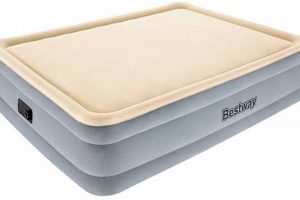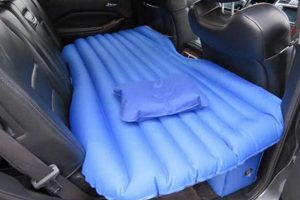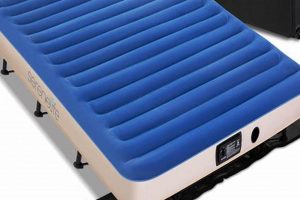Identifying the source of air loss within an inflatable mattress is a process focused on locating the point of egress. This typically involves employing sensory methods, either visual or auditory, or using a soapy water solution to detect escaping air bubbles. Effective identification allows for targeted repair and restoration of the mattress’s intended functionality.
Maintaining an airtight seal in air mattresses is crucial for ensuring comfortable and uninterrupted sleep. Failure to identify and address air leaks can result in a deflated and unusable mattress, leading to discomfort and potential sleep disruption. The ability to locate and repair these leaks extends the life of the mattress, providing a cost-effective alternative to replacement and contributing to a more sustainable consumption pattern.
The following sections will detail specific methods and techniques applicable to locating and pinpointing the source of air leakage within an inflatable mattress structure, enabling effective and efficient repair procedures.
Locating Air Leaks
The effective identification of air leaks in inflatable mattresses relies on systematic observation and testing. The following guidelines offer structured approaches to pinpointing the source of air loss.
Tip 1: Inflation and Auditory Inspection: Fully inflate the mattress and listen closely for hissing sounds, particularly around seams, valves, and patched areas. A quiet environment is essential for optimal detection.
Tip 2: Visual Examination: Conduct a thorough visual inspection of the mattress surface. Look for any signs of punctures, tears, or abrasions, paying close attention to areas that experience the most stress during use.
Tip 3: Soapy Water Solution: Mix a small amount of mild dish soap with water. Apply the solution to the mattress surface using a sponge or spray bottle. Escaping air will create bubbles at the site of the leak.
Tip 4: Submersion Technique: If the size of the mattress permits, submerge it in a bathtub or large container of water. Observe for bubbles rising from the mattress surface, indicating the location of the leak. Exercise caution to prevent water damage to the surrounding area.
Tip 5: Focus on High-Stress Areas: Concentrate inspection efforts on areas that are subject to frequent folding, bending, or pressure. These locations are more prone to developing leaks.
Tip 6: Valve Inspection: Examine the valve mechanism for any signs of damage or improper sealing. A loose or faulty valve can be a common source of air leakage.
Tip 7: Marking the Leak: Once a leak is identified, mark the location clearly with a pen or marker to ensure accurate placement of the repair patch.
These techniques, when applied diligently, provide a comprehensive approach to locating and identifying sources of air leakage in inflatable mattresses. Accurate identification is a critical step towards successful repair and prolonged mattress lifespan.
The subsequent sections will address methods for effectively repairing identified leaks, thereby restoring the mattress to its intended functionality.
1. Inflation Level
The degree to which an air mattress is inflated directly impacts the efficacy of detecting air leaks. Insufficient inflation reduces the pressure differential between the interior of the mattress and the external environment, thereby minimizing the rate of air expulsion through any existing breaches. This reduced outflow makes auditory and tactile leak detection significantly more challenging.
Conversely, over-inflation, while potentially amplifying air outflow through leaks, can also exacerbate existing damage or create new points of failure. This is particularly true in older mattresses where the material has become brittle or weakened with repeated use. The ideal inflation level for leak detection is typically that which allows the mattress to maintain its structural integrity while maximizing the pressure differential. A common scenario involves a small puncture initially undetectable at low inflation, becoming readily apparent with full inflation due to the increased air escaping.
Therefore, a calibrated approach to inflation is crucial. Inflation should proceed gradually, allowing for interim inspections. The mattress should be inflated to its recommended capacity, or slightly below, to minimize the risk of further damage while ensuring optimal conditions for identifying air leaks. A thorough inspection, incorporating auditory, visual, and soapy water tests, should then be conducted. This ensures accurate leak detection without compromising the mattress’s structural integrity.
2. Auditory Detection
Auditory detection plays a crucial role in locating air leaks, especially subtle ones, within inflatable mattresses. The method relies on discerning the sound of escaping air, a skill enhanced by a quiet environment and systematic approach.
- Environmental Noise Reduction
Background noise significantly impedes the ability to detect faint hissing sounds emanating from air leaks. A quiet environment, free from distractions such as televisions, conversations, or appliances, is essential. Conducting the auditory examination in a room with sound-dampening qualities, such as one with carpeting and upholstered furniture, can further enhance the process. This ensures focus is maintained on the subtle sounds indicating air escape.
- Proximity and Movement
The distance between the ear and the surface of the inflated mattress directly impacts the audibility of air leaks. Approaching the surface closely, while avoiding direct contact that might mask the sound, maximizes the detection potential. Slow, deliberate movement across the mattress surface allows for systematic coverage, increasing the probability of identifying the leak source. Altering the angle of approach can also reveal leaks that are initially masked by surface irregularities.
- Distinguishing Leak Sounds
Air leaks produce a range of sounds, from a distinct hissing to a faint whistling. The type of sound can provide clues about the size and nature of the leak. Larger leaks tend to generate louder, more pronounced hissing sounds, while smaller leaks may produce a higher-pitched whistling or a barely audible rustling. Recognizing these nuances through practice improves the effectiveness of auditory detection. Moreover, it is important to differentiate these sounds from ambient air currents or mechanical noises, preventing misdiagnosis.
- Complementary Techniques
Auditory detection is most effective when combined with other leak detection methods. While listening for escaping air, simultaneously conduct a visual inspection, looking for potential puncture points or abrasions.
If a suspected leak location is identified through auditory means, confirm it using a soapy water solution to visualize the escaping air as bubbles. This integrated approach minimizes the chances of overlooking subtle leaks and provides a more comprehensive assessment of the mattress’s integrity.
The application of auditory detection, when implemented thoughtfully and in conjunction with other methods, represents a valuable tool in the process of isolating air leaks in inflatable mattresses. Successful identification allows for targeted repair strategies, prolonging the functional life of the mattress.
3. Soapy Solution
The application of a soapy solution is a widely recognized and effective method for precisely locating air leaks in inflatable mattresses. This technique leverages the visual properties of soap bubbles to identify the points where air is escaping, enabling targeted repair efforts.
- Bubble Formation Mechanism
The soapy solution, typically composed of mild dish soap and water, reduces the surface tension of the water. When applied to the surface of an inflated air mattress, any escaping air will force its way through the solution, creating visible bubbles. The continuous formation of bubbles at a specific location indicates the presence and precise location of an air leak. This is particularly useful for locating minuscule leaks that are undetectable by auditory or visual means alone.
- Solution Application Techniques
The soapy solution can be applied using various methods, including a sponge, spray bottle, or brush. The choice of application method depends on the size and accessibility of the area being examined. A sponge is suitable for covering larger surface areas, while a spray bottle allows for targeted application to suspected leak points. The solution should be applied liberally enough to create a film on the mattress surface, but not so excessively that it runs off and obscures potential leaks. For example, applying a fine mist with a spray bottle to the seams of the mattress allows for precise bubble formation at the leak point.
- Optimizing Visibility
The effectiveness of the soapy solution method can be enhanced by optimizing visibility. Conducting the test in a well-lit environment allows for easier observation of bubble formation. Darker colored mattresses may require a more concentrated soapy solution to produce easily visible bubbles. Furthermore, minimizing air currents in the testing environment prevents premature bubble dissipation, ensuring accurate leak identification. In situations where visibility is limited, the use of a magnifying glass can aid in detecting small bubbles.
- Post-Application Cleaning
Following the leak detection process, it is essential to thoroughly clean the mattress surface to remove any residual soapy solution. Leaving the solution on the mattress can attract dirt and debris, potentially damaging the material over time. Wipe the area with a clean, damp cloth and allow it to air dry completely before storing or reusing the mattress. This step ensures the longevity and hygiene of the inflatable mattress. For instance, failing to remove soapy residue from a flocked mattress surface can lead to discoloration or matting of the flocking.
In summary, the strategic deployment of a soapy solution constitutes a reliable and visually-driven approach to locating air leaks in inflatable mattresses. Its effectiveness is contingent upon proper application, optimized visibility, and thorough post-application cleaning. This method, when combined with other detection techniques, provides a comprehensive solution for maintaining the integrity of air mattresses.
4. Visual Inspection
Visual inspection forms a fundamental step in locating air leaks. It involves a careful examination of the mattress surface to identify physical imperfections that may compromise its airtight seal. This method is often the initial approach due to its simplicity and non-invasive nature.
- Surface Imperfections
The primary objective is to identify any visible damage to the mattress material. This includes punctures from sharp objects, tears resulting from stress or mishandling, and abrasions caused by friction against rough surfaces. Identifying these imperfections directly pinpoints potential leak sources. For example, a small puncture, easily overlooked during casual observation, represents a concentrated point of air loss. Similarly, a tear along a seam indicates a structural weakness leading to leakage.
- Seam Integrity
Seams are critical structural components in air mattresses. They are inherently susceptible to failure due to the stress of inflation and deflation. Visual inspection focuses on the integrity of the seams, searching for signs of separation, fraying, or adhesive failure. Delamination of the seam material is a clear indicator of potential air leakage. A compromised seam presents a pathway for air to escape, gradually deflating the mattress.
- Valve Assessment
The valve assembly, responsible for inflation and deflation, is another area of concern. Visual inspection should assess the valve’s physical condition, looking for cracks, breaks, or misalignment. A damaged valve may not seal properly, resulting in continuous air leakage. Furthermore, the connection between the valve and the mattress material should be examined for signs of separation or wear, which can also compromise the airtight seal. For instance, a hairline crack in the valve housing allows for slow but persistent air loss.
- Patch Evaluation
If the mattress has been previously repaired with patches, a thorough visual inspection of these patches is essential. Assess the patch material for signs of peeling, cracking, or lifting at the edges. A poorly applied or deteriorating patch will inevitably lead to renewed air leakage. The adhesive bond between the patch and the mattress material must be intact to maintain an airtight seal. A patch with lifted edges provides an easy escape route for pressurized air.
Visual inspection, while often the initial step, is not always sufficient for locating all leaks, particularly those of a microscopic nature. However, it provides valuable insights into the overall condition of the air mattress and can identify obvious points of air loss. Its effectiveness is maximized when combined with other detection methods, such as auditory inspection and the application of a soapy water solution, providing a comprehensive approach to leak identification and repair.
5. Valve Integrity
Valve integrity is a critical factor in maintaining the air retention capabilities of an inflatable mattress. Compromised valve function represents a frequent source of air leakage, necessitating a thorough assessment as part of any comprehensive leak detection process.
- Seal Mechanism Functionality
The core function of the valve is to create an airtight seal, preventing air from escaping once the mattress is inflated. This seal is typically achieved through a combination of physical closu
re and pressure. If the sealing mechanism is damaged, worn, or obstructed by debris, it cannot effectively prevent air loss. For example, a valve with a cracked internal gasket will permit a slow but continuous leak, leading to gradual deflation of the mattress. A fully functional seal is essential for maintaining consistent inflation. - Valve Housing Integrity
The valve housing, which encases the sealing mechanism, must be free from cracks, fractures, or deformation. Damage to the housing can compromise the seal and create pathways for air to escape. Physical impacts or prolonged exposure to extreme temperatures can weaken the valve housing material, leading to failure. A cracked valve housing may not be immediately apparent but can be detected by applying a soapy water solution to the valve exterior. Damage to the housing impacts the sealing mechanisms ability to function.
- Connection to Mattress Material
The interface between the valve assembly and the mattress material is a common point of potential leakage. This connection is typically achieved through adhesives, welds, or mechanical fasteners. Degradation or failure of this connection compromises the airtight seal. Flexing and stress during inflation and deflation can weaken the bond over time. A loose valve connection allows air to seep out along the perimeter, resulting in gradual air loss. The tightness of this connection is essential.
- Proper Valve Closure
Ensuring proper valve closure is a necessary, though often overlooked, aspect of maintaining air pressure. Many valves require a specific action, such as twisting or pressing, to fully engage the seal. Failure to properly close the valve, or improper alignment of valve components, allows for unrestricted air leakage. A valve that appears closed but is not fully engaged permits air to escape, mimicking a leak in the mattress material. Correct operation of the closure mechanism ensures seal reliability.
Recognizing and addressing potential issues related to valve integrity are integral to effectively identifying and resolving air leaks in inflatable mattresses. A systematic assessment of the valve’s function, housing, connection, and closure mechanism is crucial for maintaining its airtight properties and preventing air loss.
Frequently Asked Questions
The following addresses common inquiries regarding air leak detection in inflatable mattresses. These responses aim to provide clarity and guidance in effectively locating and resolving leak issues.
Question 1: Is it possible to identify an extremely slow air leak?
Detecting minor air leaks presents a significant challenge. Prolonged submersion or the application of a highly concentrated soapy solution, coupled with meticulous observation, may be necessary. The process can be time-consuming, requiring patience and persistence.
Question 2: Can temperature affect air leak detection?
Temperature variations influence air pressure within the mattress. Lower temperatures reduce pressure, potentially diminishing the rate of air escape and complicating leak detection. Conversely, elevated temperatures increase pressure, potentially exacerbating existing leaks.
Question 3: Are certain areas of an air mattress more prone to leaks?
Seams, valves, and areas subject to frequent folding or stress are generally more susceptible to developing leaks. These areas warrant careful and focused inspection efforts.
Question 4: What type of soapy solution is most effective?
A mild dish soap solution is generally sufficient. However, excessively concentrated solutions may leave residue or damage the mattress material. The optimal concentration balances bubble formation with material safety.
Question 5: Is it necessary to fully inflate the mattress for leak detection?
Full inflation is generally recommended, as it maximizes the pressure differential and facilitates air escape through leak points. However, over-inflation can exacerbate existing damage. Inflation should proceed cautiously and incrementally.
Question 6: Can leaks occur spontaneously without any visible damage?
Material degradation, particularly in older mattresses, can result in microscopic cracks or fissures that cause air leakage without readily apparent damage. These leaks are especially challenging to locate and may necessitate replacement of the mattress.
Effective air leak detection requires a systematic approach, incorporating multiple techniques and careful observation. Addressing these inquiries promotes a more informed and successful leak identification process.
The subsequent sections will detail various methods for repairing identified leaks, thereby restoring the mattress to its optimal functional state.
Conclusion
The preceding sections have comprehensively outlined procedures for locating air leaks in inflatable mattresses. Methodologies encompassing auditory detection, visual inspection, and the application of soapy solutions, alongside focused examination of valves and seams, facilitate accurate leak identification. Mastery of these techniques contributes significantly to extending the lifespan and usability of inflatable mattresses.
Effective implementation of these methodologies requires diligence and attention to detail. Consistent application of the described techniques allows for prompt leak detection and repair, minimizing inconvenience and maximizing the utility of the mattress. Neglecting these practices can lead to accelerated mattress degradation and premature replacement, resulting in unnecessary expense and resource consumption.







